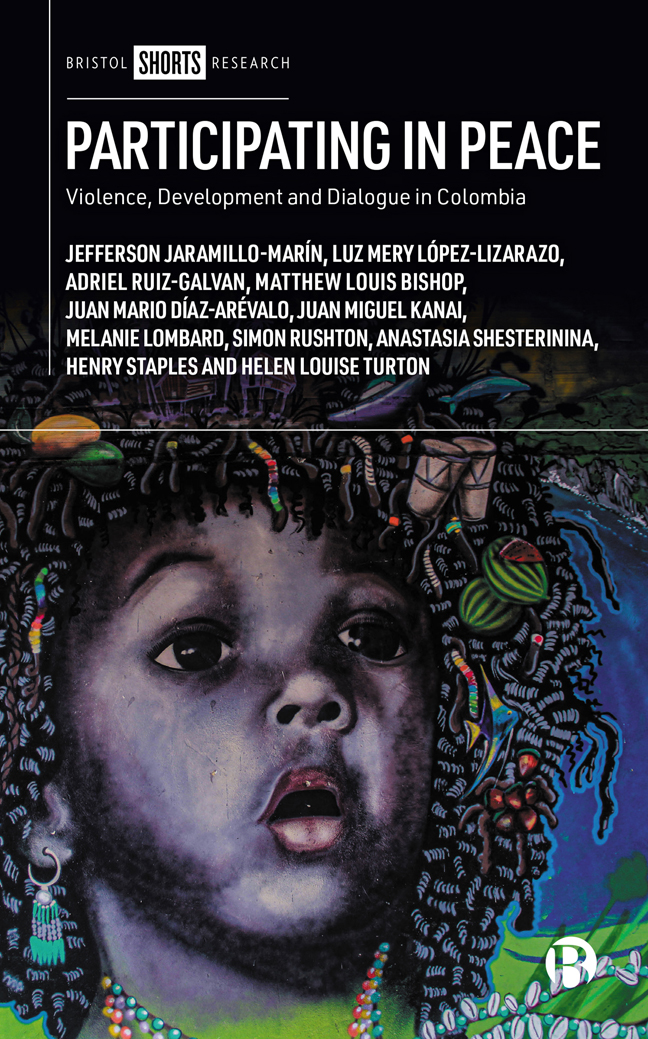Book contents
- Frontmatter
- Contents
- List of Maps and Tables
- List of Abbreviations
- Notes on the Authors
- Acknowledgements
- Note on the Cover Image
- Introduction
- One Peace through Participation: The Colombian Experience
- Two Participation through Dialogue: Co-Producing Peace and Research
- Three Protecting Catatumbo: Dialogue as Conflict-Sensitive Environmentalism
- Four Transforming Buenaventura: Dialogue for Municipal Peacebuilding
- Conclusion
- References
- Index
Three - Protecting Catatumbo: Dialogue as Conflict-Sensitive Environmentalism
Published online by Cambridge University Press: 24 January 2024
- Frontmatter
- Contents
- List of Maps and Tables
- List of Abbreviations
- Notes on the Authors
- Acknowledgements
- Note on the Cover Image
- Introduction
- One Peace through Participation: The Colombian Experience
- Two Participation through Dialogue: Co-Producing Peace and Research
- Three Protecting Catatumbo: Dialogue as Conflict-Sensitive Environmentalism
- Four Transforming Buenaventura: Dialogue for Municipal Peacebuilding
- Conclusion
- References
- Index
Summary
On the morning of 10 June 2013, a group of around 300 campesinos blocked the road connecting Tibú, the largest town in Catatumbo, to Cúcuta, the departmental capital of Norte de Santander. Central to the protestors’ concerns was the excessive use of force in the government's illicit crop eradication programme, along with unequal access to land and a lack of support for transitioning to alternative livelihoods. The blockade sparked what would become the Catatumbo agrarian strike, lasting 53 days and including around 10,000 people in an unprecedented region-wide mobilization ( Jiménez Martín et al, 2019).
During the Improbable Dialogues project's participatory scoping phase, the strike was repeatedly cited as a watershed moment for envisioning and realizing a community-led peace. The transport blockages had soon affected palm oil production, access to the Colombian Oil Company (Ecopetrol) and other commercial sectors in the region. The results included food shortages and clashes between campesinos and security forces. Although the protesters eventually obtained a response from the Colombian government, issues emerged over the extent to which the protestors were representative of the region's diverse groups, including the Motilón-Barí indigenous people. Few of the promised state concessions came to fruition and, even though the PDET programme which stemmed from the 2016 peace agreement prioritized the development of the region, it did little to change the situation on the ground. It is no overstatement to suggest that communities like those in Catatumbo have been some of the biggest losers of the conflict: as Ballvé (2013b: 238) suggests, for four decades ‘the conflation of political violence and the cocaine boom have devastated rural Colombia, fueling the displacement of some 4 million campesinos – mainly by paramilitary groups’. Yet, even after the agreement with the FARC had been reached, the people of Catatumbo continued to be plagued by a combination of illegal economies, armed violence from guerrilla and paramilitary groups, state repression and unequal access to land and natural resources.
While the contentious politics that animated the agrarian strike continue to this day, and residents acknowledge the challenges and slow pace of change stemming from the peace agreement, innovative and community-based efforts to create and sustain peace are gaining visibility and traction. Our local partners, especially the faith-based organization Pastoral Social who have long been active in the territory, introduced us to multiple initiatives, including in remote, poorly-connected parts of the region.
- Type
- Chapter
- Information
- Participating in PeaceViolence, Development and Dialogue in Colombia, pp. 57 - 82Publisher: Bristol University PressPrint publication year: 2023



